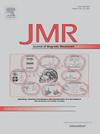Specificity and reactivity of bromoacrylaldehyde spin labels
IF 1.9
3区 化学
Q3 BIOCHEMICAL RESEARCH METHODS
引用次数: 0
Abstract
Electron paramagnetic resonance (EPR) spectroscopy in combination with site-directed spin labelling provides information on structure and dynamics of biomolecules. Increasing the availability of spin labels with different properties is an elegant way to foster a more accurate analysis of the EPR data in relation to the biological problem investigated. In this study, we present a comparative investigation of labelling efficiency, surface accessibility, site specificity and width of the distance distributions obtained on two proteins with the nitroxide-based bromoacrylaldehyde spin label (BASL) versus the two commercial spin labels MTSL (methanethiosulfonate spin label) and MAP (maleimido proxyl). Based on the predicted distances from a rotamer library approach and on the experimental distance distributions, BASL is shown to provide generally narrower distance distributions compared to the other nitroxide labels. The exquisite surface specificity of BASL with respect to MAP could be successfully exploited to selectively label surface cysteines in proteins containing a high number of native cysteines. In addition, the distinct site-reactivity of BASL and MAP towards two surface-exposed cysteines was leveraged for orthogonal labelling strategies with nitroxide and gadolinium labels.

溴丙醛自旋标记的特异性和反应性
电子顺磁共振(EPR)光谱结合定点自旋标记提供了生物分子的结构和动力学信息。增加具有不同性质的自旋标签的可用性是促进与所调查的生物学问题相关的EPR数据更准确分析的一种优雅方法。在本研究中,我们对基于氮的溴丙醛自旋标签(BASL)与两种商业自旋标签MTSL(甲乙硫磺酸自旋标签)和MAP(马来酰丙基)在两种蛋白质上获得的标记效率、表面可及性、位点特异性和距离分布宽度进行了比较研究。基于旋转体库方法的预测距离和实验距离分布,与其他氮氧化物标签相比,BASL提供的距离分布通常更窄。BASL相对于MAP的精致的表面特异性可以成功地用于选择性地标记含有大量天然半胱氨酸的蛋白质的表面半胱氨酸。此外,利用BASL和MAP对两种表面暴露的半胱氨酸的不同位点反应性,利用氮氧化物和钆标签的正交标记策略。
本文章由计算机程序翻译,如有差异,请以英文原文为准。
求助全文
约1分钟内获得全文
求助全文
来源期刊
CiteScore
3.80
自引率
13.60%
发文量
150
审稿时长
69 days
期刊介绍:
The Journal of Magnetic Resonance presents original technical and scientific papers in all aspects of magnetic resonance, including nuclear magnetic resonance spectroscopy (NMR) of solids and liquids, electron spin/paramagnetic resonance (EPR), in vivo magnetic resonance imaging (MRI) and spectroscopy (MRS), nuclear quadrupole resonance (NQR) and magnetic resonance phenomena at nearly zero fields or in combination with optics. The Journal''s main aims include deepening the physical principles underlying all these spectroscopies, publishing significant theoretical and experimental results leading to spectral and spatial progress in these areas, and opening new MR-based applications in chemistry, biology and medicine. The Journal also seeks descriptions of novel apparatuses, new experimental protocols, and new procedures of data analysis and interpretation - including computational and quantum-mechanical methods - capable of advancing MR spectroscopy and imaging.

 求助内容:
求助内容: 应助结果提醒方式:
应助结果提醒方式:


